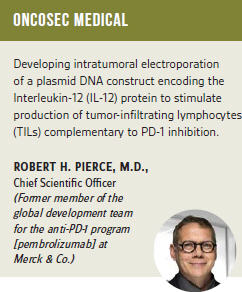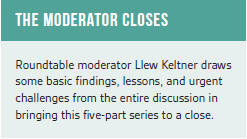Combination Cancer Immunotherapy — A Virtual Roundtable: Part V

By Wayne Koberstein, Executive Editor, Life Science Leader
Follow Me On Twitter @WayneKoberstein
Llew Keltner, M.D., Ph.D., Roundtable Moderator
A series on the challenges and opportunities of using new agents to rally the immune system against cancer.
PART FIVE: A WRAP: HOW DO THE KOLs & COMPANIES COMPARE?

In the end, there were too many responses, too many willing participants, for our virtual roundtable to include them all. We end our Combination Cancer Immunotherapy series with this final installment, Part Five, featuring input from four of the hottest companies in the field: Merck & Co. (MSD, outside North America), Five Prime Therapeutics, Heat Biologics, and OncoSec. Editorial space considerations demand a finale to the series, leaving out at least eight of the two dozen companies that submitted discussion responses and more expressing interest. Our apologies to those companies, to whom and for whom we owe some explanation.
Our final selection reflects a simple criteria: We chose companies with a range of technologies and at various stages of development, whose immunotherapies directly target the immune system primarily by altering immune cells, as do the checkpoint inhibitors. (One semi-exception, OncoSec, has an intratumoral therapy designed to be synergistic with checkpoint inhibition.) Plenty of other approaches can claim some immunotherapeutic action by targeting the tumor antigens or microenvironment. But the number of candidates and alternative mechanisms of that sort is now proliferating beyond our ability to do anything but show some examples. At some point, we had to decide when to call an end or go on forever publishing company responses.
To date, we have given a good account of the concepts and applications, theory and reality, of cancer immunotherapy. Parts One and Two thoroughly shared the range of views among key opinion leaders. The subsequent parts have covered companies’ real-world experiences trying to apply the concept in a business environment. Each company is unique in its practical views and approach. Every one holds lessons for any life sciences company taking on the risks and responsibilities of developing highly innovative products. We conclude Part Five and the series itself with the moderator’s summary of concepts and lessons discussed in the virtual roundtable as a whole.
The companies here continue to assess the reasons for using cancer immunotherapies in combinations, the criteria by which the combination components are likely to be selected, the business models most likely to prevail, and the key challenges in commercializing and delivering cancer immunotherapies to real patients in the real world. Candidates for “backbone” therapies, personalized versus off-the-shelf treatments, and alternative combinations also enter the discussion. (See also “Questions Verbatim” in Part Four, December 2014.)
 Why Combinations?
Why Combinations?
Combinations should be studied, but in certain patients a single agent will be sufficient. That is shown by our data in melanoma, where many of our responding patients have remained in remission at the two-year mark. Though they are not a majority of patients, it is a significant portion. For those patients, there may be no need for additional agents, and that will probably be true of other cancers as well.
Essential Components?
The notion of combination therapy in cancer is not new, and the lessons from that longtime standard of care can help guide choices of combinations in immunotherapy. Mechanism-based combinations should be prioritized. Given our understanding of the PD-1/PD-L1 pathway, what are the logical drugs we should bring in to combine with an agent like ours? We would need agents that contribute to the synergistic improvement in efficacy of the anti-PD-1 drug without a lot of additional toxicity. There are a number of companies now developing other immunotherapy approaches they believe will be complementary to our agent, and I spend a lot of time talking with such companies. The focus in cancer now is on immunotherapy, as it has been with other areas such as molecularpathway targeting.
Backbone Therapy?
I do believe anti-PD-1/PD-L1 will be the backbone approach for some time to come. With the extraordinary results we have seen with these agents — many now have breakthrough designations as we do with pembrolizumab in melanoma and lung cancer — it does not seem likely in the near term something else will come in to displace anti-PD-1/PD-L1. There are other checkpoint inhibitor targets under investigation; maybe in a number of years we will see something with results that eclipse those we have with our approach, but for now that is unlikely, and anti-PD-1/PD-L1 will be the backbone immunotherapy.
Combo Criteria?
Although our understanding of the mechanisms of PD-1/PD-L1 in patients is limited, there is an increasing knowledge in this space that would allow rational, mechanism-based decisions on what to include in combinations. That would primarily be other immunotherapies, but there is increasing data that other agents such as chemotherapies can alter the tumor microenvironment in advantageous ways for an anti-PD-1 agent, increasing the immuno-antigen repertoire. Epigenetic inhibitors might also be attractive candidates. That said, some of our best combinations in cancer treatment were discovered somewhat empirically. So we and others will take a broad approach to looking at combinations. Much of this will have to be sorted out in the clinic and in randomized clinical trials.
Biomarkers add another level of complexity. We are interested in applying PD-L1 as a biomarker, because higher levels of PD-L1 expression correspond to higher levels of response, though it is clear some patients with low PD-L1 expression also respond. Our registration trials in lung cancer use an “enrichment design,” which requires some PD-L1 expression in the tumor for the patient to be eligible. There is an analogy to Herceptin, which may not have ever been approved without use of the HER-2 biomarker in its pivotal trial — to ensure maximum benefit in the selected patient population. That can accelerate initial approval; then we can go back and understand whether we can extend use of the drug to some patients with low biomarker levels. We are also investigating other biomarker technologies as well, such as DNA or RNA-based biomarkers.
Narrow or Wide Applications?
With our drug, like others, we are finding there are patients with every cancer type who respond. Again, although it is not 100 percent of patients, it is clear that even a single agent is capable of having a response in individual patients with a wide variety of cancer types.
 Why Combinations?
Why Combinations?
Tumors are thought to frequently upregulate multiple immune checkpoints to escape destruction by the immune system, and for that reason, it may be more efficacious in many tumor settings to use combinations of immunotherapies. Indeed, early clinical data with ipilimumab plus nivolumab (anti-PD-1) suggest that the combination is more effective than ipilimumab alone in the treatment of advanced melanoma. Five Prime will initiate a clinical trial next year combining FPA008, our antibody targeting tumor-associated macrophages (TAMs), with BMS’s nivolumab in six cancer indications. TAMs are emerging as key cell types that suppress antitumor immunity.
Essential Components?
This will be specific to each patient’s tumor, and molecular profiling of the dysregulated immune checkpoints will likely be needed to determine the optimal combination regimen of immunotherapies to use against the specific cancer in that patient. Two or more checkpoints could be targeted simultaneously by multiple drugs with single specificities, or drugs with multiple specificities such as bispecific antibodies could be developed. In addition, combinations of immune checkpoint inhibitors with other mechanisms such as cancer vaccines, cell therapies, and immune-activating antibodies are now being tested in the clinic and will likely be part of the oncologist’s armamentarium in the future.
Backbone Therapy?
It is probably too early to tell whether one axis will be the backbone of all immuno- oncology combinations. There will be variability from tumor type to tumor type and even among patients. Already, data suggest that the CTLA-4 and PD-1/ PD-L1 pathways are more relevant for drug therapy in some tumors than others. Our understanding of therapeutic selection will become more refined as the roles of particular immune checkpoints are better elucidated across a wide range of tumors. Five Prime is developing novel checkpoints that could be used in combination with the clinically validated pathway inhibitors, but may also be used as a single agent in tumors that do not respond well to those therapies.
Combo Criteria?
Selection of specific immuno-oncology combinations will likely be done by characterizing immune checkpoint proteins (or the nucleic acid transcripts that code for such proteins) present in a patient’s tumor or immune cells. In addition, the safety profile of each drug should be considered before combining them.
Narrow or Wide Applications?
Five Prime focuses on more generalizable immuno-oncology approaches that can be given to all patients who are likely to have the relevant target for a drug such as a monoclonal antibody. However, this doesn’t mean that we can ignore what the patient’s tumor looks like. As patients, physicians, and payers demand better outcomes and probabilities of success, there will be demand for biomarker molecular profiling to select immunotherapies most likely to result in durable responses and improved survival.
Personal or Broad?
Patient cell-based approaches, such as artificial T cells expressing tumor-recognizing receptors (also known as chimeric antigen receptor-T cells, or CAR-T cells), are intriguing, and some of the Phase 1 data, particularly in hematologic malignancies, have been exciting. The CAR-T cells are reintroduced into the patient and hopefully recognize and kill the cancer cells. So every patient represents essentially a separate manufacturing lot. Despite encouraging data, significant safety and logistical issues remain. Other individualized therapies that may emerge include cancer vaccines, in which the patient’s own tumor antigens are used to boost the immune response.
For cancer immunotherapies that are monoclonal antibodies, the limits will be the traditional ones of safety, efficacy, approved indications, payer coverage, and convenience and tolerability. For cell-based approaches, given their inherent logistical complexity and safety risks because they cannot be easily turned “off,” they may be initially reserved for patients in intensive-care or salvage settings, at least in the near term.
Brian Wong, M.D., PH.D. Vice President, Research and Head of Immuno-Oncology Five Prime Therapeutics
General Comment?
Many key opinion leaders believe we have only just scratched the surface in identifying mechanisms that enable the immune system to kill tumor cells. One of the key factors hindering the discovery of the next generation of immunotherapies is the lack of mechanistic understanding of immune dysregulation in tumors. Many known checkpoint regulators do not have identified ligands. This makes drug development, rational selection of combinations, and companion diagnostic development very difficult. In addition, it is likely that many pathways that control the immune response in tumors remain to be discovered. Technologies that can uncover these ligands and pathway information will provide a competitive advantage in the field. A priority will be to work out how immunotherapies combine or do not combine with established standards of care for various cancers, as well as other immunotherapies.
 Why Combinations?
Why Combinations?
While it is possible to envision a singleagent immunotherapy, combination therapy would appear to be the most likely scenario to combat cancer. Future combinations will focus on complementary mechanisms of action, such as those that inhibit the checkpoint blockade and those that stimulate production of cytotoxic T cells. Other new and emergent mechanisms of action may come into play as well. That said, this is such a new area of exploration, and there is much work to be done. Without more combination trial data on immunotherapy agents together with and without chemotherapy, we aren’t at the point where it’s clear what combination therapies should be considered — yet, it appears clear that combining multiple agents may be the best approach for patients right now.
Essential Components?
We are only now in the early stages of this emerging field of cancer immunotherapy, a field which will undoubtedly evolve substantially over time. In the current environment, I would envision that a viable combination for many forms of cancer would include a CTLA-4 or PD-1/L1 blocking antibody or multiple checkpoint inhibitors as well as a vaccine/adjuvant to promote a robust cytotoxic T cell response against that cancer. However, groups are working with approaches that don’t utilize checkpoint inhibitors at all, and these approaches may emerge quite rapidly.
Backbone Therapy?
It depends on the setting. In the short term, checkpoint approaches will indeed remain an important part of cancer immunotherapy combinations for many, but not all cancers. One reason for this is simply that these checkpoint approaches were first out of the gate and will establish themselves as standard of care for a wide variety of cancers over the next few years. That being said, vaccine and costimulatory approaches will likely emerge as an equally important part of a combination regimen to combat cancer.
Combo Criteria?
It is a complex and rapidly changing environment, and these are very expensive therapies. While physicians will, of course, be free to prescribe combinations as they see fit, regulatory, formulary, and reimbursement realities will certainly be an important factor in the care of most patients.
Personal or Broad?
Both autologous and allogeneic approaches will likely have an important role in treating different forms of cancer. At Heat Biologics, we specialize in the development of a novel, fully allogeneic cell-based approach to activate a robust pan antigen T cell immune response against a patient’s cancer. Our approach offers certain cost, convenience, and logistical advantages. However, other approaches, such as autologous CAR-T therapy, appear to offer a very promising approach to treating certain cancers as well. In short, I can see a role for both types of therapy in different settings.
Cell-based approaches may eventually become part of the standard of care for many types of cancers because of the many unique properties that they possess. Allogeneic cell-based approaches offer the best opportunity to overcome the cost and logistical constraints preventing dissemination of cell-based immunotherapies as a class. Allogeneic approaches do not require extraction of material from a patient or personalized processing and are therefore much more cost-effective. There are fewer logistical or timing restraints, and patients may begin therapy immediately.
Commercialization Challenges?
Modern immunotherapies are still relatively young. We know that immunotherapy does not behave the same way that traditional cytotoxic chemotherapy does in terms of dose response, safety profile, and lag time to efficacy, and many of these parameters are still being evaluated in the context of clinical trial design.
In addition, while the U.S. FDA currently does not regulate cost-effectiveness of medicines, there is a clear need from a consumer and payer perspective to consider the value of products; therefore, the high cost of developing biologic products requires thoughtful streamlining of drug development processes and consideration of reimbursement strategies early on in the drug-development process.
General Comment?
Immunotherapy is an emerging and rapidly changing area, and it is difficult to predict which approach or combination will be effective for a given cancer type. Given the promise of immunotherapy to treat a wide variety of cancers, it is important that we explore not only appropriate combinations, but also the issue of cost-effectively delivering these combinations to patients who need them.
 Why Combinations?
Why Combinations?
Our drug-development strategy is to combine our IL-12 treatment with anti-PD-1 or other checkpoint inhibitors because the two mechanisms seem to work together so well. There is a “monotherapeutic fetishism” in traditional oncology; many good drugs probably would be extremely safe and have synergistic activity when combined, but they never get through development because they don’t show monotherapy activity. Fortunately, intratumoral IL-12 electroporation has monotherapy activity. So, how do we augment the immunogenicity of tumors? We use intratumoral electroporation to deliver IL-12, which sits at the top of a hierarchy of cytokines, which drives immunogenicity and potent antitumor immunity. This is not just a local ablation. With the intratumoral injection of IL-12, we get systemic immune responses in more than half of the treated patients, and we are also getting a large TIL response — the key to boosting response to anti-PD-1.
Essential Components?
All the possible components will have to go through clinical trials. The entire clinical and regulatory community recognizes that the future will bring more combination immunotherapy trials. We need to figure out means to choose rational and safe combinations and make the process more practical. Even when you have squeaky-clean molecules, regulators understandably worry about synergistic toxicities. Anti-PD-1 has a really low toxicity profile compared to say, ipilimumab or IL-2, and with our IL-12, we haven’t had a single drug-related serious adverse event. But it’s fair to say, if you’re having synergistic efficacy, you may also have synergistic side effects.
Backbone Therapy?
PD-1 therapy is a straightforward story: If you look in a microscope and you see the PD-1+ TILs in the tumor nestled together with PD-L1+ tumor and macrophages, that patient will likely respond to an anti- PD-1 drug. That is a beautiful piece of biology, but the vast majority of patients do not respond to anti-PD-1 monotherapy. This is the biggest unmet medical need in immunotherapy.
Narrow or Wide Applications?
While I was at Merck, we developed an anti-PD-L1 antibody immunohistochemistry assay, and it became immediately clear that — across the board — there exists a subpopulation of patients in most all tumor types who have the PD-L1/PD-1+ TIL “adaptive resistance” phenotype, which we know predicts response to PD-1 or PD-L1 therapy. So, the potential benefit of checkpoint inhibition cuts across almost all cancers. We have to think of tumors in a new way. In looking at response to immune checkpoint therapy, the tumor’s tissue and cell of origin doesn’t seem to matter as much as the immunophenotype. In particular, this means the presence of the right TIL signature.
Personal or Broad?
It is not wrong to think of our IL-12 drug as in-situ vaccination. But unlike other vaccines, in delivering IL-12 into the tumor, we don’t have to rationally choose a specific antigen to suit the immune system in a particular patient. Some of the more forward-thinking vaccine technology engineers a synthetic consensus of multiple antigens. We solve the problem by killing tumor cells in situ, releasing all the potential antigens present in the tumor, and letting the immune system sort out what antigens are important for response.
Commercialization Challenges?
We are already in discussions about a combination of anti-PD-1 and our drug, and there are a lot of other immunotherapy companies thinking along the same lines. Novel-novel combos are particularly challenging from a regulatory perspective. We have already seen examples of enhanced toxicity with combinations of immunotherapies. And we certainly don’t have predictive models for these therapies. Intratumoral gene therapies like ours present a preclinical safety assessment challenge because the mouse tumor models are of such short duration, typically less than three to four weeks. As a community, we will have to work toward better solutions.
We have another unique challenge: IL-12 has been shown to convert myeloid-derived suppressor cells into real APCs (antigen-presenting cells). We are in effect (not actuality) converting a tumor into a lymph node, so we don’t want to kill off the tumor completely too fast. We need to apply just the right amount of IL-12, because we need the conversion to take place and leverage the local effects to drive a systemic antitumor response.
 KOLs & Companies in Comparison
KOLs & Companies in Comparison
One of the chief aims of this virtual roundtable was to see how closely the views of key opinion leaders and company leaders matched — either among the peers in each group or between the two groups. One fact we discovered immediately was the extensive overlap of KOLs and companies in the cancer immunotherapy field. It is as if the intense excitement generated by the unprecedented responses in human trials drove key academic researchers to work with industry as never before to see the new agents all the way through to marketing approval.
Nevertheless, the KOL community also hosts the most-guarded, even pessimistic views of immuno-oncology, just as companies are the source of greatest optimism — unless, of course, they are speaking of a rival approach. (See “Companies — Convergence & Divergence.”)
We found a nearly uniform consensus on every side of the discussion that cancer immunotherapy is now a commercial and clinical reality, and combinations will be required for maximum clinical benefit. Some notable exceptions exist, however, including the belief, as expressed by KOL Alan Venook, that current data is insufficient to prove the case. (See Part One.)
We also saw a general admission that a great deal remains to be discovered about the mechanisms of action (MOAs) in the new immunotherapies, as well as MOA interactions in combination, the role of different immune-cell types, patient variability, and tumor variability in regard to immune response. But the scientific uncertainties will not deter aggressive development in the field.
In The Game
An overall picture emerges: It has become difficult to be an “oncology company” of whatever size without an effort in immunotherapy. With the consensus that immuno-oncology will constitute 80 percent or more of oncology drug therapy in the relatively near term, companies — particularly public companies — that do not claim to have immunotherapy efforts are falling out of favor with investors. Almost every company without an immunotherapy compound is trying to get access to anti- PD-1/anti-PD-L1 for a trial. Even mid-cap oncology companies are driving very hard to get into the space.
Available assets in the cancer immunotherapy space for the big and midsize oncology companies are becoming extremely scarce. For example, there are many outdated, questionably effective cancer vaccines available, but almost none of them work alone or even in combination. The older agents have been far surpassed by a very few newer, more elegantly designed vaccines, which are already taken by the big players or aspirants. There are virtually no clinical-stage checkpoint inhibitors or costimulatory molecules available, and even the preclinical ones are being heavily pursued.
Thus, some companies appear to be grabbing at theories — small molecules or antibodies that affect one axis or another — that seem like a good idea in combination with real immune modulators. Some of those will indeed prove to be good combination molecules, but may have a hard time competing with lower-cost existing alternatives. For example, low-dose metronomic oral cyclophosphamide, which is essentially free, nontoxic, and easily acceptable to PIs and IRBs, has generated very striking data in combination with vaccines, checkpoint inhibitors, and costimulatory molecules.
The largest overlooked area among the immunotherapy companies is ablation. Despite huge support and demand from KOLs for apoptotic ablation modalities in combination with immunotherapy drugs, the big players have almost universally ignored the area. They have all also missed the huge intellectual property opportunity available to them in combining immunotherapy drugs with ablative modalities.
Llew Keltner, Roundtable Moderator
The overhang of “targeted” drug development persists strongly in immunotherapy, particularly among the Big Pharmas. Virtually all of the big players are searching for “biomarkers” to select patients for trials or commercial use, despite the evidence that the most obvious biomarkers, such as PD-L1 expression in tumors, do not reliably predict response.
A huge misunderstanding of clinical reality persists in regard to immunotherapy biomarkers: With the targeted therapies, it is quite simple to look for a variant gene or target molecule in peripheral fluid, but in immunotherapy, virtually all of the proposed biomarkers are in tumor biopsy tissue. Arguably, tumor biopsies will simply prove commercially impractical; it is unlikely that patients, physicians, and payers will routinely tolerate them. Medical oncologists do not typically have the capability to do biopsies, which require referrals to interventional radiology for a dangerous, expensive, and often very uncomfortable procedure.
The importance of affordability and practicality came up numerous times in our roundtable discussion. But trouble has already appeared on the horizon. Though in a different area, Gilead’s premiumpricing of its liver-disease drug Sovaldi (sofosbuvir) and its successor, Harvoni (ledipasvir and sofosbuvir), has created a tough and questionable future reimbursement environment for new combination cancer-immunotherapy drugs. The U.S. Congress is now talking about rolling back patents for drugs deemed essential but too expensive, and the U.S. Department of Veterans Affairs is looking at a number of mechanisms for reducing the cost of specialty drugs, including oncology. For example, at a recent Congressional hearing concerning Sovaldi at the VA, the concept of the federal government “walking in” to the Gilead Sovaldi patents was discussed. Payers, federal entities, and health economists are talking about value-based reimbursement — essentially paying for success only.
Characteristically, pharma companies are being sluggish about jumping into the debate and openly working with payers to negotiate pay-for-success schemes for cancer immunotherapy, even though, with potentially huge increases in patient benefit, there is a phenomenal opportunity for profit incrementation. Ultimately the payers will force the issue, so the financially successful immuno-oncology (IO) companies may well be the ones that quickly plan and execute clinical trials that provide pharmacoeconomic data to support value-based, success-based reimbursement.
Game Changers Or Change Gamers?
Meanwhile, immuno-oncology marches on. Virtually all of the large pharmas with oncology franchises are either developing IO drugs or are actively hunting for IO assets. Almost all small and midsize oncology companies have recast themselves as cancer immunotherapy developers or are struggling to get into trials with their nonimmunotherapy assets in combination with anti-PD-1/anti-PD-L1.
Unfortunately for the big companies, few clinical-stage IO assets among the currently exciting approaches are available for licensing. As a result, the group of companies actively hunting for assets — Merck, MedImmune, Sanofi, GSK, Novartis, Pfizer, Bayer, Boehringer Ingelheim, Roche, Daichi Sankyo, Medivation, Lilly, Abbvie, Takeda, and Kyowa Hakko Kirin — are now all looking at preclinical assets.
KOLs in a number of cancer indications express rapidly increasing frustration with the resistance and inaction of the large companies to start combination IO trials. Some of the world’s most prominent KOLs have been repeatedly rebuffed by big pharmas that cite concerns about safety, intellectual property, GMP supply, “lack of clarity on approval pathway,” and other rationales for inaction.
Thus, an already big gap between KOLs and companies in cancer immunotherapy may grow even wider as business, not scientific, issues create the greatest impediment to its development and adoption. Will Big Pharma miss another historic opportunity to champion a therapeutic revolution with cancer immunooncology? Can the small companies make up for pharma’s inertia? Once again, as with all great endeavors, the real question is, will the optimists or the pessimists prevail? And this time, the whole world — particularly the cancer patients all of us in the industry must serve — really will be watching for the answer.
THE COMPANIES — CONVERGENCE & DIVERGENCE
Like the KOLs, company leaders agreed on some issues and disagreed on others:
Agreements:
- IO will become dominant in cancer therapy in the relatively near future.
- IO agents will be primarily used in combination.
- Long way to go in understanding the underlying science
- Best combinations are not currently known.
No Agreement/Consensus:
- Need for use of biomarkers in IO for patient selection
- Commercial feasibility of autologous cell vaccines
- PD-1/PD-L1 as a long-term backbone for IO
- Corporate methods for selecting, developing, and commercializing IO combinations
- Utility of using non-IO agents in combination with IO agents
- Strategies for working with partners who own the other drugs in specific IO combinations
- Universality of application of IO to all cancers
- Ease of obtaining reimbursement for IO combinations (pricing)
